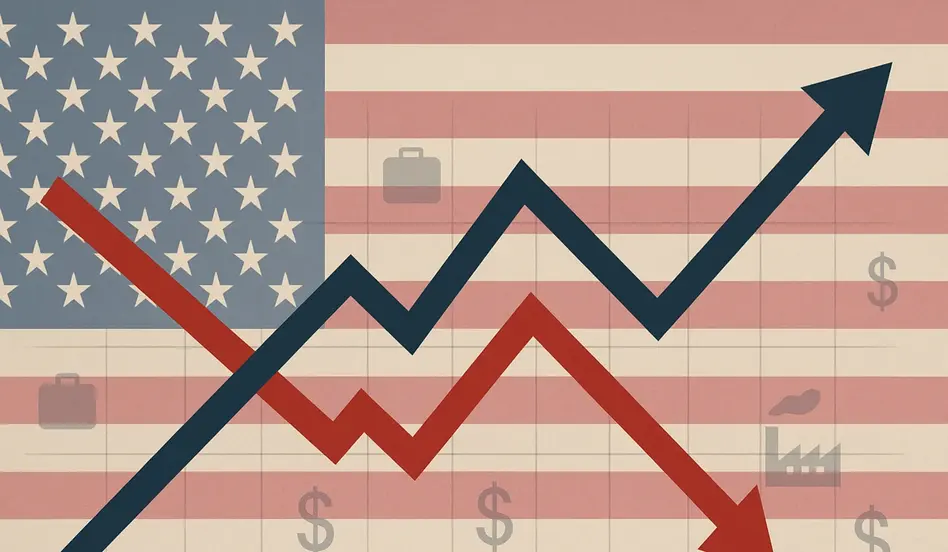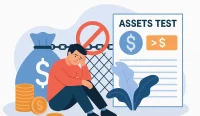US economy grows as jobless claims fall – the latest economic data has delivered a stunning rebuke to economic pessimism, showing the US economy growing at its fastest pace in nearly two years. GDP growth of 3.8% and jobless claims falling to 218,000 have created an unprecedented policy dilemma that’s dividing Federal Reserve officials and challenging conventional economic wisdom about the need for aggressive monetary stimulus.
The data reveals a complex economic landscape where strong consumer spending and business investment are driving growth, while inflation remains stubbornly above the Fed’s 2% target. Fed Governor Stephen Myron’s call for rate cuts based on a “drifting down” neutral rate stands in stark contrast to the hawkish stance of other Fed officials who see current policy as only “slightly restrictive” and appropriate for the current economic conditions.
This policy debate isn’t just academic – it has real implications for millions of American families, businesses, and investors who are trying to navigate an uncertain economic environment. The stakes couldn’t be higher as the Fed faces pressure from both political and economic forces that are pulling in opposite directions.
The Economic Data Surprise: Strong Growth Defies Pessimism
The latest economic data has delivered a stunning rebuke to those who predicted economic doom. GDP growth of 3.8% represents the fastest pace in nearly two years, driven primarily by robust consumer spending and increased business investment. This performance contradicts the narrative of an economy in trouble and suggests that current monetary policy may be more appropriate than critics suggest.
The strength of consumer spending is particularly notable, as it represents the largest component of GDP and indicates that American households remain confident about their financial prospects. This confidence is supported by a labor market that continues to show resilience, with jobless claims falling to 218,000 – a level that suggests the job market remains tight despite some cooling in hiring activity.
Business spending has also contributed significantly to growth, with durable goods orders up 2.9% in the latest report. This indicates that companies are continuing to invest in equipment and infrastructure, suggesting they remain optimistic about future economic prospects and are willing to make long-term commitments.
The data also reveals interesting sectoral dynamics, with aircraft orders driving much of the durable goods increase while computer and chip orders declined. This suggests that the economy is experiencing a rotation rather than a broad-based slowdown, with some sectors thriving while others adjust to changing market conditions.
The Fed’s Internal Divide: Myron vs. The Hawks
The Federal Reserve is experiencing an unprecedented internal divide that’s creating confusion about the appropriate path for monetary policy. Fed Governor Stephen Myron has emerged as the lone voice calling for aggressive rate cuts, arguing that the neutral rate is “drifting down” and that current policy is “excessively restrictive.”
Myron’s position stands in stark contrast to other Fed officials who are taking a more cautious approach. Austan Goolsbee has expressed skepticism about “frontloading” rate cuts given the current economic strength, while Jeff Schmitt, considered the most hawkish Fed governor, has emphasized that inflation remains “too high” and that current policy is only “slightly restrictive.”
This internal division reflects the complexity of the current economic environment, where strong growth data conflicts with persistent inflation concerns. The Fed’s decision-making process is being tested by competing economic signals that don’t align with traditional policy frameworks.
The debate centers on the appropriate interpretation of the neutral rate – the interest rate level that neither stimulates nor restrains economic growth. Myron’s argument that this rate is declining suggests that current policy may be more restrictive than intended, while other officials maintain that the current stance is appropriate for the inflation environment.
The Trade War Impact: Tariffs Reshaping Economic Patterns
The economic data reveals the significant impact of trade policies on economic patterns, with the trade balance showing the effects of tariffs in dramatic fashion. The trade deficit narrowed to $85.5 billion as imports fell by over 4% in July, following a significant increase in the previous month as businesses pulled forward expenses to avoid anticipated tariff increases.
This pattern suggests that trade policies are creating artificial volatility in economic data, making it difficult to assess underlying economic trends. The pull-forward effect of imports followed by a sharp decline creates a distorted picture of trade flows that may not reflect genuine economic strength or weakness.
The impact on specific sectors is particularly notable, with computer and chip orders declining even as overall durable goods orders increased. This suggests that trade tensions are having a selective impact on technology sectors while other industries continue to invest normally.
The trade data also highlights the interconnected nature of global supply chains, where changes in trade policy can have cascading effects throughout the economy. This complexity makes it difficult for policymakers to predict the full impact of their decisions and adjust policy accordingly.
The Labor Market Conundrum: Low Hiring, Low Firing
The labor market presents a particularly puzzling picture that’s confounding both economists and policymakers. The Fed has been talking about “low hiring but low firing” – a situation where job creation has slowed but layoffs remain minimal. This creates an unusual dynamic where the labor market appears stable despite reduced hiring activity.
Jobless claims falling to 218,000 suggests that employers are holding onto their workers even as they become more cautious about hiring new ones. This behavior pattern indicates that businesses are uncertain about future economic conditions and are adopting a wait-and-see approach rather than making dramatic changes to their workforce.
This labor market dynamic has important implications for monetary policy. If employers are reluctant to hire but also reluctant to fire, it suggests that the labor market may be in a state of equilibrium that doesn’t require aggressive policy intervention. The current unemployment rate and jobless claims data suggest that the labor market remains healthy despite some cooling in hiring activity.
The persistence of this pattern over time suggests that it may reflect structural changes in the labor market rather than cyclical weakness. This could mean that traditional policy responses may not be appropriate for the current situation.
The Inflation Challenge: Persistent Price Pressures
Despite strong economic growth, inflation remains a persistent challenge that’s complicating the Fed’s policy decisions. The latest data shows that inflation is still running above the Fed’s 2% target, creating a dilemma for policymakers who must balance growth concerns with price stability objectives.
The persistence of inflation despite strong economic growth suggests that price pressures may be more structural than cyclical. This could mean that traditional monetary policy tools may be less effective in addressing current inflation challenges, requiring a more nuanced approach to policy.
The Fed’s internal debate reflects this complexity, with some officials emphasizing the need to maintain restrictive policy to combat inflation while others argue that the neutral rate has shifted, making current policy more restrictive than intended. This disagreement highlights the difficulty of calibrating policy in an environment where traditional economic relationships may be changing.
The inflation challenge is particularly acute because it affects different segments of the population differently. While strong economic growth benefits many Americans, persistent inflation erodes purchasing power and can create social and political tensions that complicate policy decisions.
The Political Pressure: Trump’s Rate Cut Demands
The economic data has created an awkward situation for the Trump administration, which has been pushing for aggressive interest rate cuts while the economy is delivering strong growth numbers. This contradiction highlights the tension between political preferences and economic reality that’s complicating monetary policy discussions.
The administration’s call for significant rate cuts appears increasingly disconnected from the economic data, which suggests that current policy may be more appropriate than critics suggest. This disconnect raises questions about the appropriate role of political pressure in monetary policy decisions and the importance of maintaining central bank independence.
The strong economic data undermines the administration’s argument that the economy needs emergency monetary stimulus. Instead, the data suggests that the economy is performing well and may not require the kind of aggressive policy intervention that the administration has been advocating.
This situation highlights the importance of data-driven policy decisions and the risks of allowing political considerations to override economic analysis. The Fed’s independence becomes particularly important in such circumstances, as it allows policymakers to make decisions based on economic fundamentals rather than political pressure.
Frequently Asked Questions
US economy grows as jobless claims fall – what does this mean?
US economy grows as jobless claims fall to 218,000 with GDP hitting 3.8% growth, indicating strong economic performance that contradicts calls for aggressive rate cuts and creates policy confusion within the Fed.
Why is this economic data surprising?
The data is surprising because it shows the fastest GDP growth in nearly two years (3.8%) and falling jobless claims (218,000), contradicting predictions of economic trouble and creating a dilemma for Fed officials who disagree on policy direction.
What’s causing the Fed’s internal division?
Fed Governor Stephen Myron calls for aggressive rate cuts based on a “drifting down” neutral rate, while other officials like Austan Goolsbee and Jeff Schmitt maintain current policy is only “slightly restrictive” and appropriate for current conditions.
How are tariffs affecting the economic data?
Tariffs are creating artificial volatility in trade data, with imports falling 4% in July after businesses pulled forward expenses, narrowing the trade deficit to $85.5 billion and affecting specific sectors like technology differently.
What does “low hiring, low firing” mean for the labor market?
The labor market shows reduced hiring activity but minimal layoffs, with jobless claims falling to 218,000, suggesting employers are holding onto workers while becoming more cautious about new hiring due to economic uncertainty.
Why is the Trump administration’s position awkward?
The administration’s call for aggressive rate cuts appears disconnected from strong economic data showing 3.8% GDP growth and falling jobless claims, undermining arguments for emergency monetary stimulus.
A Real-World Example: The Small Business Owner’s Dilemma
Jennifer Chen, owner of a mid-size manufacturing company in Michigan, finds herself caught in the middle of the US economy grows as jobless claims fall debate. “We’re seeing strong demand for our products, but we’re also dealing with higher costs from tariffs and inflation,” she explains. “I don’t know whether to expand our operations or wait to see what happens with interest rates.”
Jennifer’s company has been experiencing steady growth, with orders up 15% over the past year. “Our customers are still buying, and we’re hiring new employees,” she says. “But every time I hear about potential rate cuts, I wonder if that means the economy is actually weaker than it appears.”
The uncertainty is affecting Jennifer’s business decisions. “We were planning to invest in new equipment, but now I’m not sure if we should wait,” she explains. “If rates are going to be cut significantly, maybe we should hold off on major investments until we see what happens.”
Jennifer’s experience illustrates how the Fed’s internal debate creates real uncertainty for business owners who must make decisions based on incomplete information. “I wish the Fed could give us clearer guidance,” she says. “Right now, it feels like they’re as confused as we are about what’s really happening in the economy.”
The strong economic data has been good for Jennifer’s business, but the policy uncertainty is making it difficult to plan for the future. “I know the economy is growing, but I don’t know if that means we should be more aggressive or more cautious,” she says. “The mixed signals from the Fed aren’t helping.”
Don’t Let Policy Confusion Undermine Economic Confidence
The US economy grows as jobless claims fall highlights the critical importance of clear, consistent communication from monetary policymakers. While strong economic data suggests that the economy is performing well, the internal division within the Fed is creating uncertainty that could undermine business confidence and investment decisions.
The Fed must find a way to reconcile its internal differences and provide clear guidance to markets and businesses. The current situation, where one governor is calling for aggressive rate cuts while others maintain a more cautious stance, is not sustainable and could lead to policy mistakes that harm the economy.
The strong economic data provides an opportunity for the Fed to take a step back and reassess its policy framework. Rather than rushing to cut rates based on theoretical concerns about the neutral rate, the Fed should focus on the actual economic data and make decisions based on observable trends.
The stakes are too high to allow internal disagreements to create policy confusion. The Fed must speak with one voice and provide clear guidance to help businesses and consumers navigate the current economic environment.




